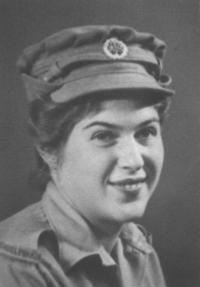We were so proud to wear Czechoslovakia’s badge on our shoulders
Mrs. Hana Pavlů was born in a German - Jewish family in Hostinne, in the Sudetenland. She attended textile clothing school in Liberec and later Brno. Sadly, her entire family save for herself and her sister died in concentration camps during the war. In 1940 she and her sister joined the illegal transport to Palestine to avoid certain death. They experienced awful trip on Milos, a cargo ship from the Romanian port of Tolcea to Haifa. She then boarded the Patria carrying 270 Jewish refugees that sank in Haifa on November 25th 1940. She miraculously survived and was transported to the internment camp in Atlithu. She entered the Czechoslovak army troops in 1942 in the Middle East, where she underwent military training by the British in Sarafand. During the years from 1943 to 1946 she acted as a member of the ATS batallion (Auxiliary Territorial Service) operating in camp Tel-El-Kebir in Egyptian desert. After she returned to Czechoslovakia in March of 1946, she was placed into one of the repatriation camps to reassimilate with displaced Czechs. Later on she lived in Prague between friends’ apartments. She suffered seriously through this ordeal from nervous system illness. She spent the rest of her professional life working in the Pharmaceutical Research Institute, until her death in 2013.

